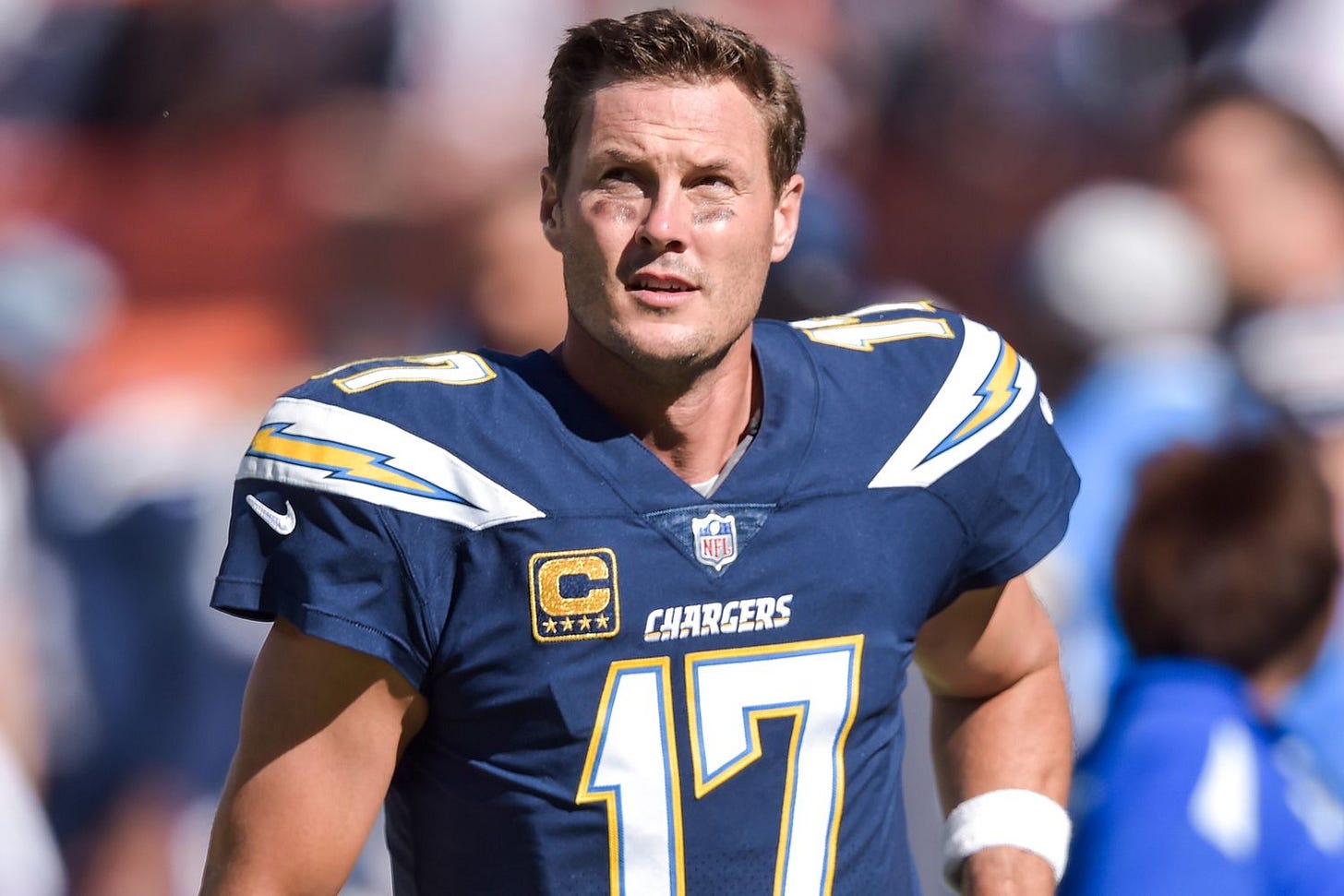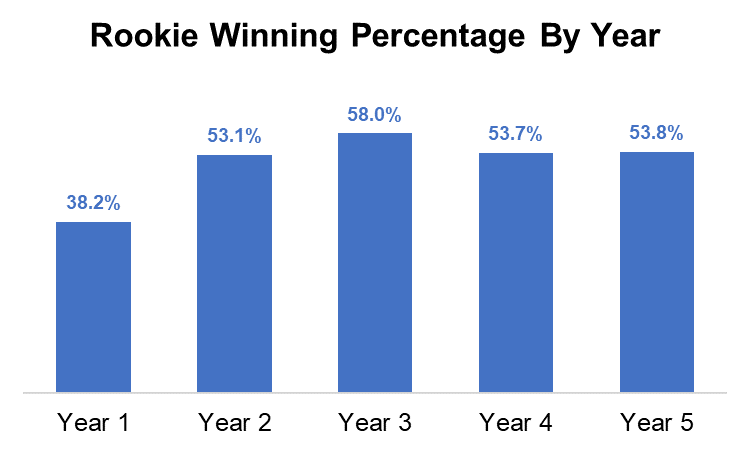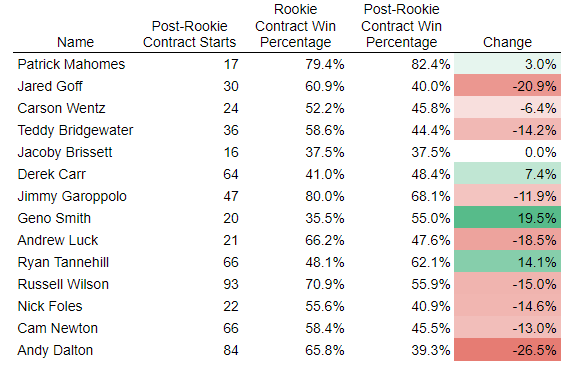Welcome To The Veteran QB Trap
The myth of winning big while paying a quarterback what he’s worth
In the NFL’s fixed-salary era, there are two primary ways you can build a team. One, you invest premium money in the most important position - quarterback. Two, you invest in everyone else.
Last year’s Super Bowl pitted the two against each other. The Kansas City Chiefs shoved all their chips into the Patrick Mahomes basket - giving $36M, 20% of their salary allotment, to the best player in the sport and pinching pennies elsewhere. The Philadelphia Eagles cheaped out on QB, using rookie-contract Jalen Hurts ($1.6M) and surrounding him with the best teammates in the NFL (ESPN ranked nine Eagles in the top 10 of their positions, most in the league).
Other than QB and tight end, where the Chiefs have the best players in the league, the Eagles spent more than the Chiefs at basically every other position. It created the league’s third-best offense, sixth-best defense, and a ferocious top-to-bottom unit.
The Chiefs eked out the Super Bowl on Mahomes magic but the story of the playoffs was the triumph of method #2. Of the eight teams in the quarterfinals, six had QBs on rookie deals. The rookie deal is key because NFL rules lock in a player’s first four years of salary based on their draft slot alone1. On the open market, top-end QBs are worth $30-$50 million a year (see Herbert, Justin) but they’re getting about a tenth of that on their first contracts.
Conventional wisdom says rookie-deal quarterbacks are great when they hit. However, the price is fair because it reflects the uncertainty of trusting your franchise to a 22-year old straight out of college. Many rookies are bad, the thinking goes, so it’s not a free lunch.
I disagree. Rookie-deal quarterbacks are still undervalued. They are a free lunch. The average one plays like Kenny Pickett and wins like Phil Rivers. They provide enough surplus value to make the average team a playoff team. The moment they are paid market value, the pixie dust wears off and they can’t get back to that level.
This wasn’t always the case. As recently as 2010, top picks got market-rate deals closing on nine figures. The owners, annoyed at this direction, staged a lockout and renegotiated the labor deal. Unsurprisingly, the NFL player’s union screwed their future members at the expense of their present ones - locking in lower, fixed wages for rookies and ensuring higher pay for current players. Almost overnight, the average pay for a first-round pick dropped by half.
The next year, the rookie QB phenomenon was born. While Sam Bradford, the first pick in 2010, got a $78 million contract, Cam Newton, the first pick in 2011, got barely $20 million. We now have 10 draft classes of QBs who’ve spent 3+ years in the league - 2011 through 2020. I looked at each of their careers to examine the rookie effect:
After a short acclimation period, the average rookie quarterback fields a winning team by Year 2. In fact, over the last 4 years of the contract, the teams win ~55% of their games. That’s enough most years to make the playoffs! Heck, Phil Rivers and Eli Manning may make the Hall of Fame and they’ve only won 53% of their starts between them.
Why the huge jumps in the first two years? Part of it will be the quarterbacks learning the ropes, and adjusting to life at the professional level. More of it, admittedly, is selection bias. Almost every QB drafted in the first three rounds does get a real chance to prove himself. Of the 48 in my dataset, 44 got at least five starts. But many crash and burn at the controls, so by year 3 about a third are cycled out. Kicking the Josh Rosens (3-13 lifetime record) and DeShone Kizers (0-15) to the curb helps the overall numbers.
But then a funny thing happens. Even as quarterback quality stabilizes - 75% of those who make it to year 3 get to year 5 - production starts dipping. And it keeps dipping after Year 5.
In an abstract world, you’d expect this graph to be up and to the right. Quarterbacks peak in years 7-9 of their career, producing twice the value they do in years 3-4. Since they’re both getting better and survival of the fittest screens out the bad ones with time, the group who makes it to year 6 and beyond should be winning more, not less.
So what’s happening after year 3? You guessed it, they start signing big deals. Salaries stay unchanged for year 4 but rise in year 5 and spike (to 3-4x year 5 salaries) from year 6 onwards. By year 4, teams begin planning ahead and have to cut or trade their top supporting players to make room for the quarterbacks. And that outweighs the improvements these quarterbacks make, bringing these “veteran QB” teams under league average.
It’s not a case of a couple scrubs bringing down the average. Here is every quarterback with at least one season of starts after their rookie contract.
Just four of the 14 players improved on their rookie contract performance, and two of those (Geno, Tannehill) only made their hay after joining a talented team on backup money. Another one is Mahomes, the exception proving every rule.
All of these quarterbacks beat the Darwinian nature of the NFL for years. On their rookie deals, 10 won at least 52% of their games and 12 led a team to the playoffs, most multiple times. It’s hard knowing what we know now to pull back in time, but QBs like Wilson, Newton, Luck, and Carr were at different times hailed as The Next Big Thing in the NFL.
It wasn’t to last. Playing at 10% of their market value, they got surrounded by elite talent; when teams invested in them, they got better, but not enough to make up for the departed players. Eventually, their teams cut the expensive QB astray, drafting a rookie replacement. A worse player, but a better contract. The Cincinnati Bengals are a perfect example:
2011-2015: Win 66% of their games with rookie-contract Andy Dalton
2014: In the middle of the run, they sign Dalton to a $96M contract extension
2016: Dalton’s extension kicks in
2016-2019: Win 38% of Dalton’s games.
2020: Draft Joe Burrow with the #1 overall pick
2020-2022: Win 59% of their games with rookie-contract Joe Burrow
2023: Who is up for a $265M extension? You guessed it, Joe Burrow.
That deal looks great now. Burrow has made back-to-back conference championship games, and may well - like Mahomes - prove to be well worth it. But this data would make me queasy if I was a fan of the Chargers, the Eagles, or the Ravens. All handed out huge extensions to quarterbacks this summer who have much shorter track records of playoff success, even with superteams around them.
The normal conversation around young QBs is patient: if they pop, awesome, but playoff success takes time and people need to take their lumps before they win. This data smashes a hole in that theory. Rookie QBs have a year to learn the ropes: after that, it should be a default that teams can build a winner around them. The good ones will have real playoff success by years 3 and 4, and only the great ones will sustain that in year 6 and beyond.
Your best chance at a title might hit you years before you’re at peak form, even for Hall of Fame quarterbacks. Rivers went 46-18 on his rookie contract and 88-88 after. Big Ben won 2 titles on his first deal and diddly-squat after. Russ and Cam made the Super Bowl three times on rookie deals and haven’t gone beyond the quarterfinals since. Only the inner ring of the elite (Brees, Manning, Rodgers, Brady, Mahomes) have been impervious2.
The implied subplots this season are juicy.
For the incredible QB class of 2020 (Burrow, Herbert, Hurts, and Tua), this is Year 4. The last year of max surplus value. Potentially their best chance for a title.
For the elite QBs of 2017 and 2018 (Deshaun Watson, Josh Allen, Lamar Jackson), this is the first year of being paid at market rates. Was their prior success a contract illusion, in all or in part?
I can’t wait to find out.
The typical deal locks in salaries for four years, with teams having an option to extend the contract for a 5th year at a below-market rate if they choose.
And offenses coached by Sean McVay / Kyle Shanahan (see: ‘17 Falcons, ‘19 49ers, ‘21 Rams). But that’s a story for another day.







It does make you wonder why more QBs don’t willingly cap their top-end contracts to allow for a better team to be built around them. I’d have to imagine Hurts, Burrow, or Jackson would be perfectly happy and financially secure forever with a 5-year/$100MM fully guaranteed contract and this would increase their chances of competing for more super bowls.